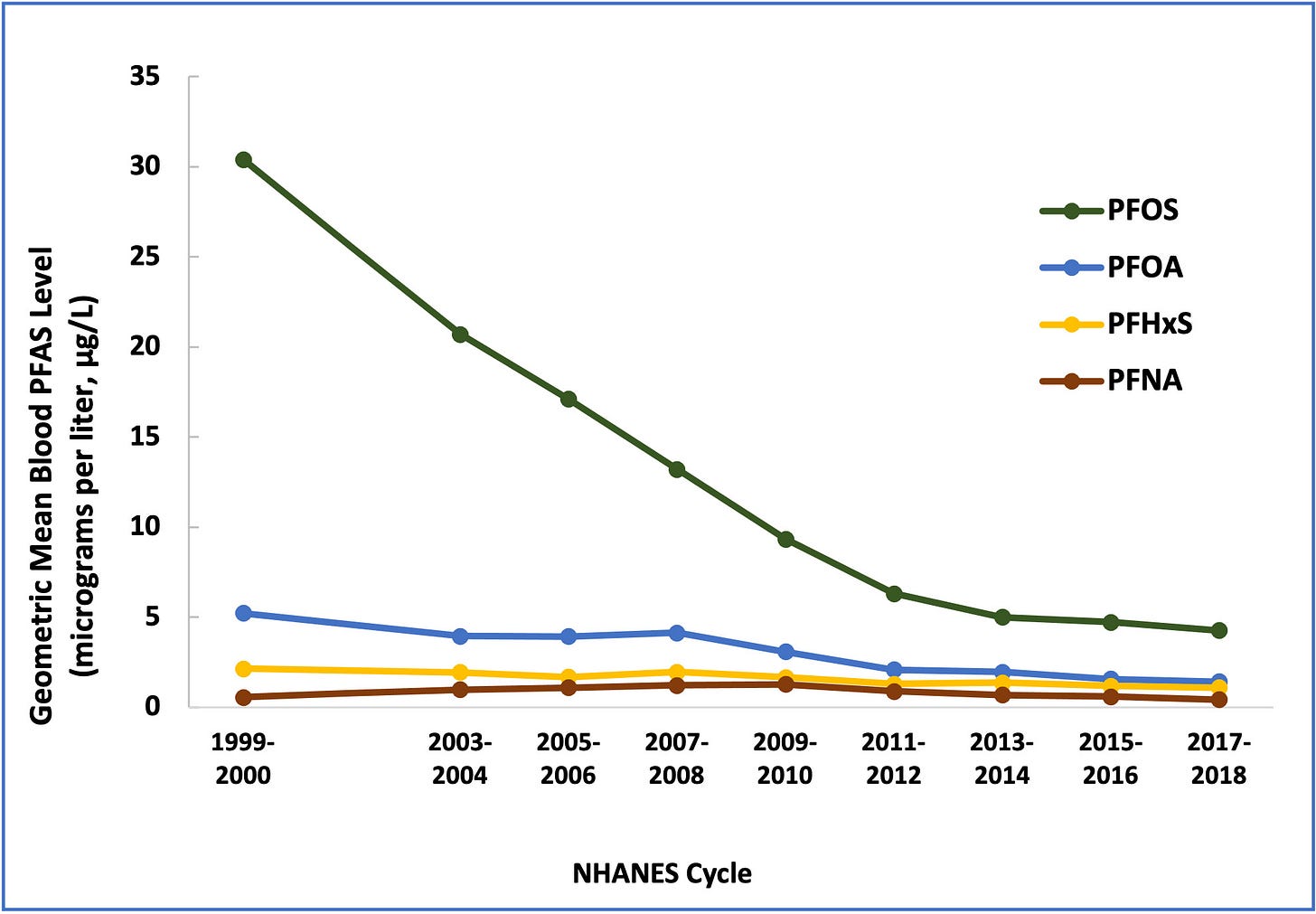Water repellent clothing and PFAS - are they a danger to us?
DWR (durable water repellent) coating used for waterproof clothing often contains molecules called PFAS or "forever compounds". I go deep into the research to see what the actual risk is to humans.
TLDR at the end.
This is the first post on synthetic clothing in general. But I am starting from a point I see as most dangerous and highest risk to damage our health - DWR and waterproof clothing.
This field has been irking me for quite some time to check the facts and a recent tweet by Pieter Levels finally made me go deeper into it:
Terms
nylon - a synthetic material usually used for waterproof clothing (technically polyamide - PA);
DWR coating - something typically put on nylon, to make it water repellent.
PFAS - a family of ~5k molecules, which are made of fluorine and carbon and usually have an extremely long shelf life.
PFOA, PFOS, C8, C8, PFHxS, PFNA - some of the 5k molecules, all under the PFAS family (this one is confusing!)
PFAS
PFAS has increasingly been in the news as the “forever molecules”. It apparently can accumulate in our blood and increases the risk of various health issues. The scary part - it is found on many household goods. And among it - on water repellent clothing, covered with DWR coating.
Source: instagram
DWR coating - the good (PFAS free)
DWR coating, inducing water repelling properties used to use and in most cases still does use the so called forever chemicals (PFAS). However, there is now a transition to remove it from the formulation. Often that means less water repellency.
Patagonia has a fairly good explainer that there are more variants of these forever chemicals and lists perfluorocarbons, per- and polyfluoroalkyl substances (PFAS, PFOS, PFOA). It is also interesting how they quote that the research has advanced and initially included long-chain (C8) fluorocarbon based molecules as dangerous and later expanded to shorter chain (C6) as well. Source: Patagonia.
I briefly looked into what the non-PFAS or non-PFC DWR coating is made of. The game appears to be to design as even and non-porous surface as possible in order to prevent water from sticking onto it. Some of the approaches are to use wax (reminding of the waxed cotton barbour jackets) or to use silicon (which derives from sand) nano-particles. Some more advanced theory can be found here: paper.
DWR coating - the bad (with PFAS)
On the flipside, there are still plenty of waterproof clothing, covered with DWRs which use PFAS. And that is a risk.
What is PFAS chemically?
PFAS are molecules made of bonds of fluorine (very dangerous) and carbon (building block of all things living). They are some of the most durable molecules known and can take thousands of years to break down naturally or need 1000C+ to be incinerated (p6, source).
How does PFAS reach the human body?
The PFAS molecules from DWR coatings on clothes leach into the water and soil. This interesting but complex paper (p7) estimates that a single DWR coated nylon waterproof jacket contains around approx. 1.5g of PFAS(*), all of which gets released into the waste water in 400 wash cycles (so <4 mg per wash). From my understanding the washing release declines with each subsequent wash, but that’s not the point - you certainly do not want to have these concentrations of PFAS in your drinking water. And according to the same paper, around 5% of what gets released recycles back to the water supply, with most of the remainder being released back into soil and then easily migrating back into ground water (p7, source).
Thus we end up getting these compounds back through our drinking water. (Is bottled water safer? - topic for another post).
At least it seems that purely touching DWRs has a lot lower PFAS exposure - 700 times less than through washing (p6).
What are the health dangers with PFAS?
Now for the dangers of PFAS. I was not aware but the initial evidence comes from a 70k people study used in a lawsuit against DuPont and related to C8 (PFOA) compound, one of <5000 PFAS molecules. This is a direct quote from their website:
“there is a Probable Link between exposure to C-8 and the following Human Diseases.
pregnancy-induced hypertension (including preeclampsia),
kidney cancer,
testicular cancer,
thyroid disease,
ulcerative colitis, and
high cholesterol (hypercholesterolemia).”
Why DuPont? PFAS are a core building block of materials called Teflon (or PTFE) (think non-stick pan coating - another topic for a post). DuPont owns rights to the Teflon brand name and the underlying PTFE material itself actually has a $2-3bn annual market size. The lawsuit related to workers and people around the manufacturing plant.
The mentioned study relates to only one of the molecules out of ~5k, but the expanding research seems to show that other PFAS molecule types also result in increased health risk.
At which PFAS concentrations are we in the danger zone?
Based on mostly rat studies, a generalised measurement can assume that anywhere from the levels of 0.001 mg/kg/day exposure the danger zone kicks in (data below is for one specific molecule - PFOS). The exposure limits are very varied for different molecules in this family, so let’s focus on PFOS for this illustration.
Source: paper
Extrapolating animal data for humans, for an average European of 70kg, the dangerous exposure levels start at 0.070 mg/day for PFOS.
DWR washes into water, which we then drink. So how much of it is there?
So far studies found PFOS in drinking water in the US for up to 12 ng/L and in China for up to 10 ng/L (Shenzhen and Guangzhou). Thus it is still quite wide off the mark for dangerous exposure of 0.070 mg a day (=70,000 ng a day). To reach that level one would need to drink 7000 litres a day.
Worth stressing that this is based on animal data and is for only one of the dangerous compounds, which is also one of the most under control.
There is also the risk of exposure through accumulation - where drinking only small amounts over time will add up in our blood, since it takes years to clear it from the blood.
So why the worry about PFAS in general?
The PFAS molecules are worrisome because they are so indestructable, they are even called “forever compounds”. They tend to accumulate in the environment, soil and water, thus if the industry is not controlled, there is risk of reaching those dangerous levels through accumulation.
On the flipside, the body is apparently able to clear it out from the blood over time if the exposure is limited. The data from the US shows, that changing the industry habits, led to a dicrease of PFOS in the population - although that process takes years.
Certain communities can be at much higher exposures for these chemicals though.
Source: CDC
TLDR & summary on DWR and PFAS:
DWRs of old and still many today contain dangerous molecules called PFAS.
PFAS molecules take up to 1000s of years to disintegrate naturally and accumulate in the water supply and later human blood.
There are up to 5k different chemical variants of PFAS molecules, with differing exposure limits and health risks.
It is proven that exposure over time to variants of PFAS molecules leads to numerous very dangerous health risks.
Washing a DWR coated with PFAS jacket can release several mg of PFAS molecules into the waste water.
The PFAS after washing travel to water treatment plants where filtration happens into sludge, but quickly migrate into soil later.
The PFAS compounds are extremely hard to completely destroy as burning them is not straightforward.
Our tap water supply (in US and China) so far seems to contain PFAS 1000s of times below the dangerous limits of exposure. This can be different in high risk areas. No clear data for Europe was found.
I think it is still important to control the accumulation of these PFAS / forever molecules for the future.
Risks not mentioned here: exposure to PFAS through non-water routes, such as fish, cosmetrics or non-stick pans; PFAS risk to the ecosystem and nature besides humans.









